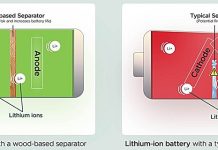
In a world constantly seeking better ways to harness solar energy, a group of scientists has made a significant breakthrough.
Researchers from the University of Bristol in the UK and the French CEA Commissariat à l’Energie Atomique have developed a groundbreaking probe capable of withstanding temperatures as hot as molten lava—reaching up to 1,400°C.
This innovative device could greatly enhance how we produce solar energy, making it more efficient and cost-effective.
Industries like steel and nuclear power have long depended on the ability to control and analyze molten metals.
However, traditional methods of examining these red-hot liquids are slow, expensive, and often lack the ability to provide immediate results.
This is especially problematic for the solar cell industry, which uses molten silicon.
Detecting impurities in this silicon is crucial for producing efficient solar panels, but the extreme environment poses significant challenges.
To tackle these issues, the research team set out to create a method that allows for real-time analysis of molten silicon, aiming to detect even the smallest impurities.
Their solution?
A high-temperature probe equipped with innovative rotary blades. These blades stir the molten silicon, ensuring a clean and stable surface for analysis.
The device uses a technique called laser-induced breakdown spectroscopy (LIBS), which analyzes the interaction between laser light and matter to determine the composition of substances. While LIBS is a powerful tool, applying it to molten metals has been tricky. The surface of these metals, when exposed to air, can change chemically, making it difficult to get accurate readings. Additionally, the intense heat can interfere with the laser beam, further complicating the analysis.
The team’s mechanical stirring approach overcomes these obstacles.
By continuously stirring the molten silicon, the device creates a fresh and stable surface for the laser to analyze. This method not only improves the accuracy of the measurements but also allows for the detection of impurities in real-time, a significant advantage over traditional methods.
This new probe offers a faster, cheaper, and more effective way of ensuring the purity of molten materials used in solar cells. By detecting impurities more efficiently, solar cell manufacturers can produce higher quality panels, leading to more efficient solar energy production.
While the research has so far focused on molten silicon, the technology has the potential to be applied in other high-temperature settings, offering benefits to a wide range of industries.
Having proven their device’s effectiveness with molten silicon, the researchers are now looking to test its capabilities in other extreme environments.
Their work paves the way for broader industrial applications, from steel manufacturing to nuclear energy, where controlling and analyzing molten materials are critical.
In essence, this breakthrough device not only promises to enhance the production of solar cells but also opens up new possibilities for improving processes in industries that deal with high temperatures.
As we continue to search for more efficient and sustainable energy solutions, innovations like this offer a glimpse into a brighter, cleaner future.



